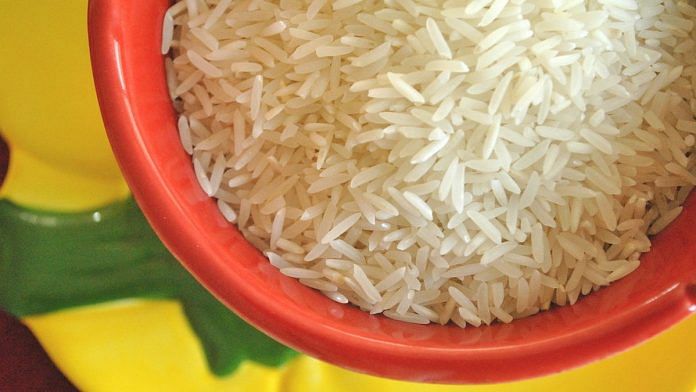New Delhi: India’s basmati rice exports perform poorly even as the agriculture trade is expected to hit a record-high of $43 billion (around Rs 3.22 lakh crore) by the end of this fiscal, ThePrint has learnt.
Basmati rice shipments fell approximately 23 per cent to $1.85 billion (Rs 14,000 crore) between April and October 2021 from $2.43 billion (Rs 18,000 crore) in the year-ago period, according to data from Agricultural and Processed Food Products Export Development Authority (APEDA), an arm of the commerce ministry.
Saudi Arabia, Iran, Iraq, Yemen and the UAE were the top importers last year for this aromatic rice, which is grown in the Indo-Gangetic Plain region. India competes with countries like Pakistan for basmati exports.
Basmati rice exports accounted for 19.44 per cent of APEDA’s export basket in 2020-2021, according to Ministry of Commerce and Industry data released last week.
Meanwhile, non-basmati rice, which was the top performing agri product in 2020-21 with a 23.22 per cent export share, saw a 48 per cent surge to $3.45 billion (Rs 26,000 crore) in April-October 2021 from $2.33 billion (Rs 17,000 crore) in the year-ago period.
Nepal, Bangladesh and African nations like Benin, Senegal and Togo were top importers for India’s non-basmati rice.
In December, Union Minister of State of Commerce and Industry Anupriya Patel said India’s agri exports will reach a target of $43 billion in 2021-22. This figure is likely to be achieved despite challenges like the pandemic and farmers’ protests.
Also read: Exports up 37 pc to record USD 37.29 bn in Dec; trade deficit widens to USD 22 bn
APEDA says stock pile-up hurt basmati
APEDA Director Tarun Bajaj told ThePrint that stock pile-up was the primary reason behind the poor performance of basmati exports.
“Excess orders led to a stock pile-up for buyers last year, so new orders are coming in cautiously. However, we’re hoping this will be corrected in the current quarter,” he said.
Bajaj added that increased global demand is the main driver of India’s high agri exports this year, after India assured foreign nations that it can cover their food security needs during the pandemic.
“All through the pandemic, people were relying more on Indian goods, be it agricultural, horticultural or processed food products. They looked to India to cover their food security needs,” Bajaj said. “India is now being seen as a consistent supplier.”
It’s important to note that products under APEDA’s ambit account for about half of India’s total agricultural exports.
According to Bajaj, out of the total export target of $43 billion for this fiscal, APEDA products are likely to account for $22.5 billion (Rs 1.6 lakh crore) while marine products, spices, tea, coffee and other products will account for the rest.
In 2020-21, India’s agri exports soared to a six-year high of over $19 billion (Rs 1.42 lakh crore). This was a nearly-25 per cent growth over $15.9 billion (Rs 1.19 lakh crore) in 2019-20.
High freight charges, logistical issues
According to an industry leader, the reason basmati exports have suffered in 2021-22 is because of high freight charges and issues over maximum residue levels (MRL) in pesticides for basmati.
“First, exporters have been facing high freight charges for over a year now, brought on by container shortages and other factors. And second, there are huge regulatory measures like MRL in pesticides for basmati,” said Anil Kumar Choudhary, senior executive director at All India Rice Exporters Association (AIREA).
However, the APEDA director said the issue over MRL has been a long-standing issue prior to 2021 and the government is working towards rectifying it.
While India’s agri exports are likely to reach the target of $43 billion by the end of this fiscal, the figure is still short of the $60 billion target envisaged in the Agriculture Export Policy 2018.
Asked what is needed to help the industry grow further, Choudhary said: “More corporatisation is required along with government assistance. Also, logistics and transport need to be improved for bringing products from farms and interior places to ports. For example, makhana products from Bihar lack a robust, logistical supply chain to reach international markets.”
India’s share in world agricultural exports stood at 2.1 per cent in 2019, according to data released by the World Trade Organization.
Also read: India’s mfg activities during Dec see substantial, albeit slower, rise in sales, output






